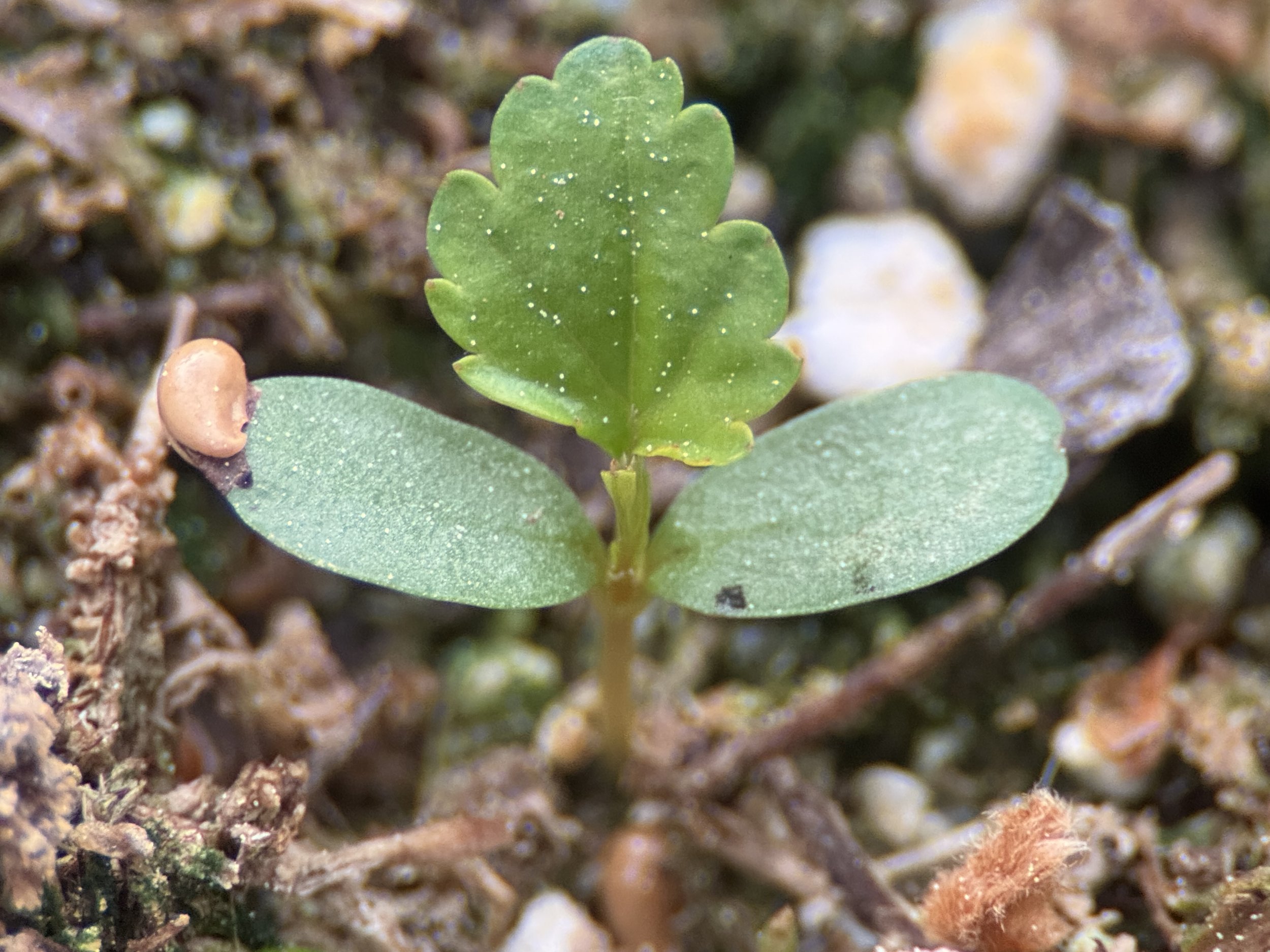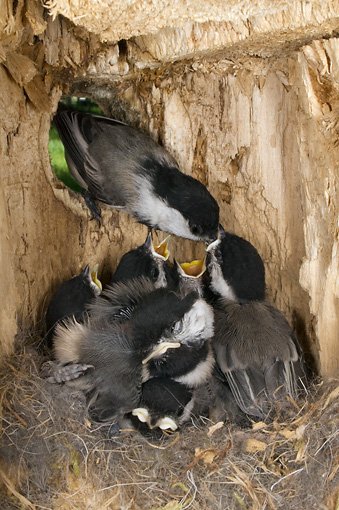
why native plants?
Ozark-native plants graced the prairies, savannas, and forests of our region long before European settlers arrived. They are naturally adapted to the Ozark climate and soils, and they co-evolved and developed an interdependent relationship with the native wildlife here over thousands of years.
Native plants are the foundation of the food web that sustains wildlife, and their decline can have far-reaching consequences. They provide food and habitat for birds and insects, promoting biodiversity. By using Ozark native plants in your landscape, you support local wildlife which play a crucial role in our ecosystem.
The deep, fibrous root systems of many Ozark native plants prevent erosion, improve soil structure, and increase the amount of rain that can infiltrate soil and recharge the water table. They reduce stormwater runoff and slow down flooding, improving overall watershed health. They are much better than non-natives at sequestering carbon (absorbing CO2).
Native plants offer much more than visual beauty in your landscape. They are a powerful tool for reversing ecosystem degradation and habitat loss. Using native plants brings your landscape to life and connects it with the natural world around you. You don’t have to be a green-thumb or even a land-owner to start being a steward of the land. Whether you’re ready to start small or go all in, our local-ecotype native plugs can help you create a landscape that reflects the rugged beauty of the Ozark region.
supporting ecological interdependence
< Carolina Chickadees feed their nestlings almost exclusively caterpillars, which are soft enough to shove down their throats safely and high in carotenoids essential to young birds’ growth. Their eggs hatch in late spring, and both mom and dad forage for caterpillars from 6am to 8pm, every day for about two weeks. They work together to bring their babies about 500 caterpillars a day, and about 7,000 caterpillars total in the nestlings’ first two weeks after hatching! They have been observed bringing as many as 17 different species of caterpillars to their nestlings in a single day, often with three or four caterpillars in their beak at a time, and all done within a 150 foot radius of their nest.
With such a large appetite and such a diverse menu, it becomes clear that Carolina Chickadees will choose to build a nest and lay eggs where there is a good supply of food for its young, and that means a large number and diverse selection of native plants hosting many different species of caterpillars. Research has shown that native plants support 15x as many caterpillars as non-natives. Native keystone trees such as Oaks and Hickories host the highest number of species of caterpillars, but planting keystone shrubs, forbs, and grasses in your yard will also help attract more songbirds, native bees, and butterflies.
< A Monarch caterpillar eating the leaves of Butterfly Weed.
The milky sap of most Milkweed species not only contains chemicals toxic to most insects, it also gums the mouth of many insects shut. Monarch caterpillars co-evolved with the Milkweed genus and developed adaptations that allow them to eat Milkweed leaves without worry. If Milkweed disappears, so will Monarchs.
Adult Monarchs will come to your yard if you plant native Milkweeds along with their favorite nectar plants, like Rough Blazing Star, Swamp Marigold, Showy Goldenrod, and New England Aster. Our Monarch Madness Garden Kit has three species of Milkweeds and six species of nectar plants, 38 plugs total.
< Roots of native Switchgrass can get to depths of 8 feet, and can easily penetrate hardpan clay. Along with Little Bluestem, Big Bluestem, and Eastern Gamagrass, Switchgrass once dominated the tallgrass prairies of the Great Plains. Less than 5% of these prairies remain. The farmlands that now dominate the midwest have rich, deep, fertile soils partially as a result of thousands of years of these prairie grasses. Our switchgrass is grown in both 5” deep plug trays and 10” Deepots.
< Our first Black Tupelo sprout, 2nd week of March. Also called Black Gum, but it’s not gummy, and it’s not related to Sweet Gum. Black Tupelo trees in our region host 26 different species of Lepidoptera (moths and butterflies) larvae. Drupes from female trees are highly nutritious for songbirds. In the fall, leaves turn brilliant orange and red.
our process
local seed
Seed is sourced from straight-species wild-type parent plants within the Ozark ecoregion whenever possible. About 25% was hand-collected by me this year; the rest were sourced from one of three reputable native seed suppliers in the Ozark region. In the future we hope to get to 100% hand-collected. We will never use seed treated with neonicitinoids, and we will never wild-dig native plants except where development is imminent and there is no plan in place to protect or relocate the plants.
pre-treatment
We spent many late nights in October and November cleaning, organizing, labeling, and storing seeds.
containers
We sow seed in 5” deep plug trays (50-cell for single-species, 38-cell for Garden Kits) and 10” Deepots for trees and other deep-rooted species. Many of the plants we grow will develop deep, complex root systems (Leadplant and Prairie Ninebark roots, for example, can grow 15 feet deep!). Deep plug containers give native plants a chance to grow roots down instead of out. Once outplanted, they “take” much faster than quart, gallon, or larger container plants. Planting plugs is easier on your back (minimal digging), your wallet ($4 for 5” plugs, $10 for 10” plugs—about $1 per inch of roots) and your garden (less soil disturbance).
winter sowing
Many native plants produce seeds that need a cold-moist stratification period to break dormancy as a safeguard against early germination and winter-kill. We stratify some of the more complicated species in the fridge in damp sand, but most seed is sown directly into the containers in winter to experience the freeze-thaw cycle, which helps break down hard seed coats. As long as night-time temps are still below about 50 degrees, the seeds are experiencing stratification. Upon completing stratification, the seed’s unique genetic coding signals that it is safe to germinate, breaking dormancy.
no greenhouse
All our containers stay outside from when seed is sown in the Winter until they are ready to be outplanted in the fall. Through sub-zero temperatures, snow, and 50+mph wind gusts, our native seeds hunkered down and waited for more hospitable conditions, just as they do when they fall to the ground in nature and are covered with leaves or snow and sink into the soil a bit with every freeze and thaw.
soil
We use a custom mix of ProMix BX and crushed gypsum, and we add soft rock phosphate for calcareous-tolerant species. Later in the spring we will sub-irrigate containers with a diluted natural fish fertilizer during their rapid growth phase. You won’t need to fertilize after planting. No need for pesticides either, as native plants will attract beneficial insects to take care of any pest problems over time.
fall-ready
October/November is the ideal time to get your native plants in the ground, and all of our plants are conveniently timed to be ready for sale in the fall.
species we’re growing
_ _American Hophornbeam. American Persimmon. American Wild Plum. Black Tupelo. Common Pawpaw. American Beautyberry. American Black Elderberry. Bursting-Heart. Buttonbush. False Indigo Bush. Maryland Senna. New Jersey Tea. Possumhaw Viburnum. Prairie Ninebark. Shrubby St. John's Wort. Smooth Alder. Virginia Sweetspire. Wild Hydrangea. Azure Sage. Blue Wild Indigo. Bradbury’s Bee Balm. Butterfly Weed. Cardinal Flower. Common Sneezeweed. Compass Plant. Downy Wood Mint_ _
_ _American Hophornbeam. American Persimmon. American Wild Plum. Black Tupelo. Common Pawpaw. American Beautyberry. American Black Elderberry. Bursting-Heart. Buttonbush. False Indigo Bush. Maryland Senna. New Jersey Tea. Possumhaw Viburnum. Prairie Ninebark. Shrubby St. John's Wort. Smooth Alder. Virginia Sweetspire. Wild Hydrangea. Azure Sage. Blue Wild Indigo. Bradbury’s Bee Balm. Butterfly Weed. Cardinal Flower. Common Sneezeweed. Compass Plant. Downy Wood Mint_ _
_ _Eastern Red Columbine. Foxglove Beardtongue. Frost Aster. Grayhead Coneflower. Great Blue Lobelia. Hairy Mountain Mint. Illinois Bundleflower. Lanceleaf Tickseed. Leadplant. New England Aster. Ohio Spiderwort. Ox Eye Sunflower. Ozark Bluestar. Ozark Coneflower. Pale Purple Coneflower. Partridge Pea. Prairie Alumroot. Prairie Blazing Star. Prairie Junegrass. Purple Poppy Mallow. Purple Prairie Clover. Rattlesnake Master. Rough Blazing Star. Showy Goldenrod. Spider Milkweed. Spotted Bee Balm_ _
_ _Eastern Red Columbine. Foxglove Beardtongue. Frost Aster. Grayhead Coneflower. Great Blue Lobelia. Hairy Mountain Mint. Illinois Bundleflower. Lanceleaf Tickseed. Leadplant. New England Aster. Ohio Spiderwort. Ox Eye Sunflower. Ozark Bluestar. Ozark Coneflower. Pale Purple Coneflower. Partridge Pea. Prairie Alumroot. Prairie Blazing Star. Prairie Junegrass. Purple Poppy Mallow. Purple Prairie Clover. Rattlesnake Master. Rough Blazing Star. Showy Goldenrod. Spider Milkweed. Spotted Bee Balm_ _
_ _Stiff Goldenrod. Swamp Marigold. Swamp Milkweed. Sweet Black-eyed Susan. Sweet Joe-Pye Weed. Upright Prairie Coneflower. Western Ironweed. Western Sunflower. White Wild Indigo. White Wingstem. Wild Bergamot. Wild Golden Glow. Wild Strawberry. Wooly Rose Mallow. Yellow Crownbeard. Yellow Wingstem. Coral Honeysuckle. Dutchman’s Pipevine. Big Bluestem. Eastern Gamagrass. Little Bluestem. Prairie Dropseed. River Oats. Sideoats Grama. Switchgrass_ _
_ _Stiff Goldenrod. Swamp Marigold. Swamp Milkweed. Sweet Black-eyed Susan. Sweet Joe-Pye Weed. Upright Prairie Coneflower. Western Ironweed. Western Sunflower. White Wild Indigo. White Wingstem. Wild Bergamot. Wild Golden Glow. Wild Strawberry. Wooly Rose Mallow. Yellow Crownbeard. Yellow Wingstem. Coral Honeysuckle. Dutchman’s Pipevine. Big Bluestem. Eastern Gamagrass. Little Bluestem. Prairie Dropseed. River Oats. Sideoats Grama. Switchgrass_ _
“In the past, we have asked one thing of our gardens: that they are pretty. Now they have to support life, sequester carbon, feed pollinators and manage water.”




